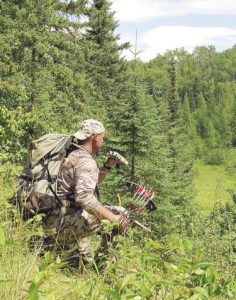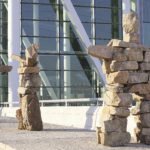 Up here in Northwestern Ontario, bow hunting season for white-tailed deer officially opens in most areas on September 1. For many, open season is also the end of summer vacation, a return to school or work, and generally getting back into the fold of a daily routine.
Up here in Northwestern Ontario, bow hunting season for white-tailed deer officially opens in most areas on September 1. For many, open season is also the end of summer vacation, a return to school or work, and generally getting back into the fold of a daily routine.
But long before the daylight hours wane and the leaves change colour under crisp, autumn nights, avid hunters are out on the land, taking weeks—sometimes months—to prepare for the long, quiet waiting game in the woods.
In John Kaplanis’ case, hunting and harvesting is a year-round, seasonal affair. The executive director of the Northwestern Ontario Sportsmen’s Alliance (NOSA) bow hunts a variety of wild game, including bear and turkey in the spring, and moose and white-tailed deer in the fall. He’s also an occasional hunting guide, angler and fur trapper, finding time for it all between his day job as a fire fighter and officer of Thunder Bay Fire/Rescue, and as a husband and father of two teenaged children.
Like him, most modern-day hunters have adapted to advanced tools and technology. They use trail cams, tree stands and flashy, lethal gear. Lamentingly so, gone are the days of traditional longbows, left only for those with the dedicated time and diligence to hone the precision and skill for this style of hunting.
But in a lot of ways, what’s being done here has inherently remained the same. Bow hunters today or a thousand years ago are ideally no more than 20 yards away from their white-tailed targets when they shoot. And in order to accomplish that, there are some pretty unbendable rules.
“Staying silent, scent-free and invisible in the woods is the name of the game,” advises Kaplanis, who washes and stores his camouflage clothes in scent-free containers, and takes time to clean and fix his tree stands in the off-season, including any squeaky equipment. “Details matter.”
“I spend a considerable amount of time at my hunting destinations, scouting and preparing trails, clearing shooting lanes, putting out game cameras…just learning as much as I can about my hunting surroundings. The activity that goes on there when you’re not hunting is just as important as when you’re there to hunt,” he tells me.
Kaplanis owns private land that he uses for hunting, and cultivates it to become more hospitable to big and small game. While food plot construction is relatively new to the north, he’s learned to grow plants that attract and benefit deer and grouse. Using equipment, he creates openings and edges that wildlife prefer, offering greater food availability and minerals for nourishment.
“I believe good habitat leads to great body condition in wild game, providing them with greater ability to fend off parasites and predators,” he cites.
It’s undeniable that hunting and harvesting can involve a heck of a lot of time and physical preparation. But the process tugs at something deeper within us if we pay attention: a sense of acute awareness, compassion, triumph and belonging when a kill is successful—the hunter suddenly becomes a direct and engaged participant in the food chain. Frequent fruitless hunting also beckons humility in that we are indeed interdependent, and not uncommonly slighted by the hand of nature.
For Kaplanis, the hunting lifestyle has shaped him into a mentor for young people who are just starting out on this path.
“My connection to the land, the animals and the forest is holistic and the more I can do to be a part of its dynamic, the more complete I feel as a human being. But passing this along to younger people, specifically my own children, has been the most rewarding element of the entire experience. Passing this lifestyle and heritage on to future generations is so important and it’s a big part of what NOSA’s objectives are all about. Finding ways to interest youth in the outdoors, hunting, fishing and trapping, has been the greatest reward of my work with the organization.”
Whether it’s a celebratory feast or casual consumption, food has brought people together since time immemorial. As for hunting, what’s all the preparation for if not to gather, share and eat?
“When we sit down for family meals of wild game, we insist on doing it as an entire family. All four of us spend time in the kitchen together and there is something to be said for this. It’s a special, almost sacred moment each time we can do this. We hunt, fish and eat together. I can think of no better way to offer reverence to the wild animals we harvest,” said Kaplanis.
Amen to that.




